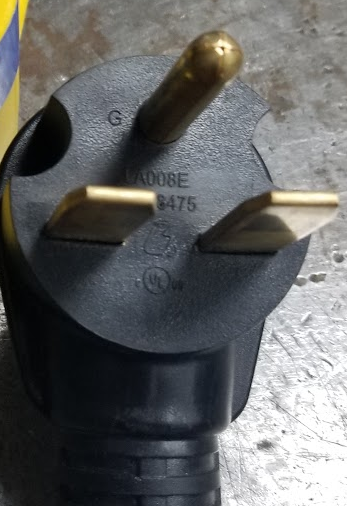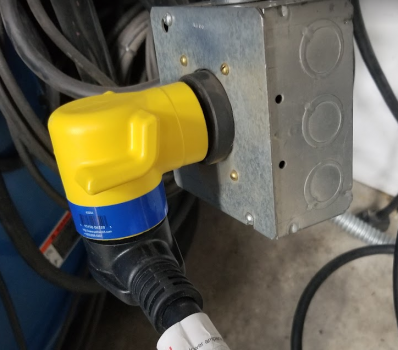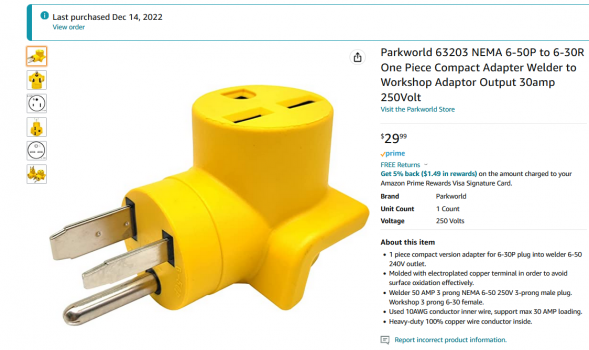You are using an out of date browser. It may not display this or other websites correctly.
You should upgrade or use an alternative browser.
You should upgrade or use an alternative browser.
240V Plug Adapter Question
- Thread starter Bühlmann
- Start date
Congrats on your new Jen-Ken oven. On the plug your shop is wired with the 50R recepts for the welder? The 50R recept is not the one for your welder? If no plans to need a 50 amp at that point, your idea of replacing the 50R with a 30P recept is what I would do.
I know it was mentioned at the other forum to swap the plug, but "IF" a 50 amp is never needed at that point I'd tend to leave the oven stock and change the recept. Either way works, just a bit cleaner changing the recept and leave the molded on 30P on the oven cord.
I know it was mentioned at the other forum to swap the plug, but "IF" a 50 amp is never needed at that point I'd tend to leave the oven stock and change the recept. Either way works, just a bit cleaner changing the recept and leave the molded on 30P on the oven cord.
MTBob
Well-Known Member
I just went through this exact problem with my new Paragon HT oven. Paragon says that the warranty is void if I change the plug end. My shop also has a 6-50R outlet I use for my welders. Paragon says that it is OK to plug the 30 amp plug into the 50 amp circuit. I also do that with a number of my other 240 machines.
My 50 amp female connection looks like this:

The 30 amp Paragon male plug looks like this:

So, I searched... and searched for a wired pig tail conversion couldn't find one... until I ran across this from Amazon:

This is actually a much cleaner conversion than a wired pig tail, a perfect solution.

My 50 amp female connection looks like this:

The 30 amp Paragon male plug looks like this:

So, I searched... and searched for a wired pig tail conversion couldn't find one... until I ran across this from Amazon:

This is actually a much cleaner conversion than a wired pig tail, a perfect solution.

Last edited:
MTBob
Well-Known Member
In my opinion, yes. I connect a number of 240v, 20 and 30 amp pieces of equipment to my 50 amp circuit. BUT not at the same time, just one at a time. As long as the connected load(s) does not exceed the breaker & wire sizing for that circuit (in my case 50 amps) then there should be no problem.Can I plug it into a 240/30 drier plug with an adapter?
I'd recommend checking with a licensed electrician if you have doubts about your wiring arrangement.
John Wilson
Well-Known Member
Just to aid anyone with a question about 30amp vs 50amp circuits, because many people get confused about this.
The device that you plug in only cares about two things: Correct Voltage, and that the circuit you're plugging it into can carry its load.
Voltage: In North America your 220 outlet will range from 220 to 240 volts. It's the same thing, just like people refer to 110, 115, or 120... Same thing. In a house, if you have one hot leg and a neutral, it's in the range of 110 - 120v. Two hot legs from different phases gives you what is referred to as 220, 230, 240. It's a range, but it's all the same thing.
Amps: The circuit is rated for how many amps it can safely conduct. The device is rated in how many amps it draws to run. The point being that the circuit does not 'push' amps to the device. It is the device that you plug in that determines how many amps will flow. So long as the circuit you're plugging into is wired to carry AT LEAST as many amps as the device requires to run, you are good to go.
For example, if you plug a 10 amp device into a 100 amp circuit the device will still only draw 10 amps. You will not hurt any device by plugging it into a circuit that is rated for higher amps. The reason that 220/240 volt 30amp and 50amp plugs are different is to keep you from plugging high amp draw devices into low amp circuits, because if the breaker doesn't trip it could cause a fire. (Amps cause heat, and too many amps for the wire will cause it to burn up. The circuit breaker is there to protect the wire in your wall from over-current. It is not to protect your device.)
The device that you plug in only cares about two things: Correct Voltage, and that the circuit you're plugging it into can carry its load.
Voltage: In North America your 220 outlet will range from 220 to 240 volts. It's the same thing, just like people refer to 110, 115, or 120... Same thing. In a house, if you have one hot leg and a neutral, it's in the range of 110 - 120v. Two hot legs from different phases gives you what is referred to as 220, 230, 240. It's a range, but it's all the same thing.
Amps: The circuit is rated for how many amps it can safely conduct. The device is rated in how many amps it draws to run. The point being that the circuit does not 'push' amps to the device. It is the device that you plug in that determines how many amps will flow. So long as the circuit you're plugging into is wired to carry AT LEAST as many amps as the device requires to run, you are good to go.
For example, if you plug a 10 amp device into a 100 amp circuit the device will still only draw 10 amps. You will not hurt any device by plugging it into a circuit that is rated for higher amps. The reason that 220/240 volt 30amp and 50amp plugs are different is to keep you from plugging high amp draw devices into low amp circuits, because if the breaker doesn't trip it could cause a fire. (Amps cause heat, and too many amps for the wire will cause it to burn up. The circuit breaker is there to protect the wire in your wall from over-current. It is not to protect your device.)
MTBob
Well-Known Member
Well said John, you nailed it.Just to aid anyone with a question about 30amp vs 50amp circuits, because many people get confused about this.
The device that you plug in only cares about two things: Correct Voltage, and that the circuit you're plugging it into can carry its load.
Voltage: In North America your 220 outlet will range from 220 to 240 volts. It's the same thing, just like people refer to 110, 115, or 120... Same thing. In a house, if you have one hot leg and a neutral, it's in the range of 110 - 120v. Two hot legs from different phases gives you what is referred to as 220, 230, 240. It's a range, but it's all the same thing.
Amps: The circuit is rated for how many amps it can safely conduct. The device is rated in how many amps it draws to run. The point being that the circuit does not 'push' amps to the device. It is the device that you plug in that determines how many amps will flow. So long as the circuit you're plugging into is wired to carry AT LEAST as many amps as the device requires to run, you are good to go.
For example, if you plug a 10 amp device into a 100 amp circuit the device will still only draw 10 amps. You will not hurt any device by plugging it into a circuit that is rated for higher amps. The reason that 220/240 volt 30amp and 50amp plugs are different is to keep you from plugging high amp draw devices into low amp circuits, because if the breaker doesn't trip it could cause a fire. (Amps cause heat, and too many amps for the wire will cause it to burn up. The circuit breaker is there to protect the wire in your wall from over-current. It is not to protect your device.)
Wire sizing. 220/20 amp can be run on #12 gauge wire. 110/40 amp would require #8 gauge depending on distance and voltage drop. Both by the way will use the same amount of electric on your electric bill. One just splits the amperage over two legs. Plus I don't know anyone that makes a 40 amp single pole breaker. lol
But according to above information. You would be totally ok to plug a 120 volt electric toaster into a 100 amp breaker as long as the wire size to where the toaster is plugged into is ok. Believe me there is a HUGE difference in when a breaker trips with a direct fault from 100 amp to 20 amp. Or for that matter 50 amp to 30 amp. A breaker is designed to protect your wire, your appliance, yourself and your home or shop.
I looked at above device on Amazon. IDK but I could find no reviews and could never find if it was UL approved.
But according to above information. You would be totally ok to plug a 120 volt electric toaster into a 100 amp breaker as long as the wire size to where the toaster is plugged into is ok. Believe me there is a HUGE difference in when a breaker trips with a direct fault from 100 amp to 20 amp. Or for that matter 50 amp to 30 amp. A breaker is designed to protect your wire, your appliance, yourself and your home or shop.
I looked at above device on Amazon. IDK but I could find no reviews and could never find if it was UL approved.
Last edited:
MTBob
Well-Known Member
Great comment. I did not see that the Parkworld device was not UL approved. Looking at the company's website, curiously, other wired-type pig tail converters seem to be UL approved, but not the molded puck style that I purchased. I'm not sure what to make of that.I looked at above device on Amazon. IDK but I could find no reviews and could never find if it was UL approved.
With a bit more searching I see that Home Depot sells what looks like the same device by a company called AC Works, for over twice the price of the Parkworld device. AC Works converter makes no reference to UL approval. https://www.homedepot.com/p/AC-WORK...VAC-Female-Adapter-AD650630/310466459#overlay
But also, I've now found several wire-type pig tail converters that would serve the purpose and claim to be UL approved. However, reading closely, the UL approval appears to apply ONLY to the "wire" itself, not the entire plug assembly.
So, while I would prefer to see a UL approval on electrical devices, in this case, I'm going to use the molded puck for the plug conversion. It's a judgment call that I consider minimal risk (particularly when compared to all the other crazy stuff I do in my shop).
Bühlmann
Well-Known Member
I’ll make you a deal, MTBob. I’ll call you if my shop burns down, and you call me if your shop burns down. But only if it’s an electrical fire originating from the plug adapter. We’re in this together now, but don’t be calling me because your shop burned from doing those fantastical FIF flame balls out of your quench tank!
MTBob
Well-Known Member
Yesiree, I'm feeling the bond.We’re in this together now,
Interesting about the UL approval. Claiming UL approval for only the wire when it's used in a pigtail the've molded in I don't think is legit. Not at all - not that I think it's not safe, but still not UL approved for the full assembly.
I would prefer to see the 50 amp breaker changed to a 30 amp for the oven and the recept changed. I do suspect the 50 amp breaker was chosen for the welder - perhaps on the same circuit? I've got a 30 amp breaker on my welder, which will trip if I turn the welder up to max of 300 amps. Since I never use more than 150 amp on the welder (1/8" rods max) the 30 amp holds just fine.
With that all said, "assuming" the wire is sufficient size for the 50 amp breaker I don't really see a real problem there. Does the welder use the same recept? OR, is the recept for the oven only?
I would prefer to see the 50 amp breaker changed to a 30 amp for the oven and the recept changed. I do suspect the 50 amp breaker was chosen for the welder - perhaps on the same circuit? I've got a 30 amp breaker on my welder, which will trip if I turn the welder up to max of 300 amps. Since I never use more than 150 amp on the welder (1/8" rods max) the 30 amp holds just fine.
With that all said, "assuming" the wire is sufficient size for the 50 amp breaker I don't really see a real problem there. Does the welder use the same recept? OR, is the recept for the oven only?
Bühlmann
Well-Known Member
I have 3 independent 50 amp circuits in my workshop. I did that specifically for the welder, but I didn’t have the workshop layout finalized when electric was roughed in, and the cost was nominal for the added flexibility of just making all of my 220v outlets 50amp capable.
MTBob
Well-Known Member
My 50 amp circuit is dedicated & sized for a 50 amp welder load (Miller 251 MIG). As discussed, I see no problem individually connecting lesser loads to the circuit.Interesting about the UL approval. Claiming UL approval for only the wire when it's used in a pigtail the've molded in I don't think is legit. Not at all - not that I think it's not safe, but still not UL approved for the full assembly.
I would prefer to see the 50 amp breaker changed to a 30 amp for the oven and the recept changed. I do suspect the 50 amp breaker was chosen for the welder - perhaps on the same circuit? I've got a 30 amp breaker on my welder, which will trip if I turn the welder up to max of 300 amps. Since I never use more than 150 amp on the welder (1/8" rods max) the 30 amp holds just fine.
With that all said, "assuming" the wire is sufficient size for the 50 amp breaker I don't really see a real problem there. Does the welder use the same recept? OR, is the recept for the oven only?
I agree about the UL approval, certainly raises questions about how that process works. The converter plug is likely made in China. I don't want to go down the UL/China approval rabbit hole, but here is a quick link that may offer some insight: https://www.chinaimportal.com/blog/ul-certification/
